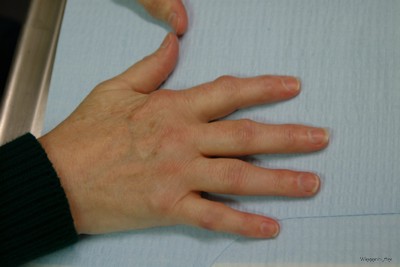U.C.L.A. Rheumatology Pathophysiology of Disease Course Lecture, Second Year Medical School 2005
Animation: Infected vs Not : Inflammation due to infection vs noninfected inflammation is discussed.
Animation: Infected vs Not : Inflammation due to infection vs noninfected inflammation is discussed.
Animation: Infected vs Not : Inflammation due to infection vs noninfected inflammation is discussed.
Inflammation due to infection vs noninfected inflammation is discussed.


The first foot has gout. The patient's immune system is responding to the presence of uric acid crystals within the tissues. Polys are attempting to engulf these crystals, however, they impale themselves, and lyse, spilling their cellular contents into the tissue.
The second foot has a Staph infection. You cannot tell the difference by examination. When you have inflammation, especially intense inflammation or monoarticular inflammatory arthritis, you must tap the joint to rule out infection. Always be concerned about the possibility of infection.
The examination of this hand will be very different from the hands we've seen so far. The joints are swollen, and there is some redness. The joints feel boggy and warm. The pattern is also quite different, with involvement of MCP, and PIP joints and sparing of the DIP joints. There is a slight ulnar drift. This is a hand of a patient with Rheumatoid Arthritis.